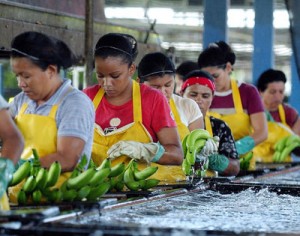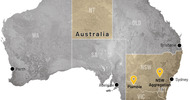Investment in agriculture is soaring. So, worryingly, is distrust of markets and trade
“THE world’s attention is back on your cause.” That was Bill Gates talking to agricultural scientists gathered recently to honour the late Norman Borlaug, father of the Green Revolution. The tycoon-turned-philanthropist was right. This week, the world—in the guise of 60-odd heads of state including the pope—held the first United Nations food summit since 2002. As the world’s attention turns from the receding financial crisis, it is switching to one emerging in agriculture.
The UN conference on food security took place at a point of relative calm between two storms. The first occurred in 2007-08, when world food prices experienced their sharpest rise for 30 years. Food riots swept through three dozen countries and two governments (Haiti’s and Madagascar’s) were overthrown by the events that the price rises set in train.
The next storm is likely within a few years and everyone fears its arrival. The price spike of 2007-08 was the result of structural imbalances in the world food chain, not just temporary fluctuations like bad weather or government mistakes. These imbalances have not gone away: food demand is still rising because of changing appetites and rising incomes in emerging markets; biofuels are still competing with food crops for available land; yield growth in cereals is declining.
In 2008-09 food problems were masked for a while by the financial crisis. But as Jacques Diouf, head of the UN’s Food and Agriculture Organisation (FAO), said this week, “when the recovery picks up, we will be back to square one.” Jeffrey Currie of Goldman Sachs argues that while most recession-hit industries in the rich world are operating at 60-70% of capacity, agriculture is at full capacity, in the sense that last year’s cereals crop was the largest on record and there is little fallow land ready to be taken under the plough. If there were another supply or demand shock, the farm-trade system would not cushion the blow.
It may not be many years away. In the first ten months of this year, food prices rose by 9.8%, prompting fears of a resumption of the surge that began in 2007, the first of the two years of crisis (see chart, left). The “breakfast commodities” (tea, cocoa, sugar, important sources of calories in some parts of the world) are trading at their highest levels for 30 years. Worse, the price respite, while it lasted, did nothing for the poorest and most vulnerable. According to the FAO, the number of malnourished people in the world rose to over 1 billion this year, up from 915m in 2008 (see chart, below). Economists at the World Bank reckon that the number living on less than $1.25 a day will rise by 89m between 2008 and 2010 and those on under $2 a day will rise by 120m. A quarter of a century after a famine in Ethiopia which dramatised failings in the food system, famine is again stalking the Horn of Africa. Has anything been done to prepare for future food shocks?
Certainly, say most governments. Money is starting to pour into agriculture after 30 years of neglect. There has been a spasm of institutional reform. And public and private sectors are doing more to help farmers than ever.
At their meeting in L’Aquila in July, the Group of Eight (G8) large rich economies promised to increase spending on agricultural development by $20 billion over the next three years. Not much of this was new money (probably $3 billion-5 billion) and it is not clear how much, if any, has been delivered. The amount also falls far short of the $44 billion that the FAO guesses will be needed each year to end malnutrition (and even shorter, aid agencies reflect, of the $14 trillion poured by rich countries into their banks). Still, the amount is not trivial. It would finance for three years the annual $7 billion that the International Food Policy Research Institute (IFPRI), a think tank in Washington, DC, estimates will be the bill for developing countries to protect agriculture from the impact of climate change. And it excludes the far greater sums developing countries themselves are promising to farming.
Agriculture and food security have become “the core of the international agenda”, as the G8 called it. In 2009, the World Bank increased its spending on agriculture by 50%, to $6 billion. The Islamic Development Bank is creating an agriculture department for the first time.
Barack Obama asked Congress to double to just over $1 billion America’s aid for agricultural development in 2010. And in a sign that food productivity means more than warm words and cash, he nominated a pundit, not a politician, to head USAID, the assistance agency: Rajiv Shah, the chief scientist for the Department of Agriculture. In the West, there is a new consensus on the need to invest more in agriculture in emerging markets.
Jeffrey Sachs, an economist at America’s Columbia University, has argued that the next step should be to create a new international agency to co-ordinate all the money and perhaps have a big budget of its own. He wants something similar to the global fund to fight HIV/AIDS, a public-private partnership. Earlier food shortages, in the 1970s, had also produced institutional shake-ups: the International Fund for Agricultural Development (IFAD) and the Consultative Group for International Agricultural Research (CGIAR), influential groups in the field, were both set up then.
But the latest crisis has not spawned any institutional children, mainly because the UN food agencies—FAO, IFAD and the World Food Programme—spent too much time bickering. Instead, institution-building took the form of tinkering. The idea for what was grandly labelled a global partnership on food security began with the French president, Nicolas Sarkozy, in the spring of 2008 and morphed into a UN committee and a “high-level task force” attached to the secretary-general’s office. So far, this modest arrangement seems to be working rather well, at least in terms of mobilising attention and resources.
The most important activity, though, is taking place at the national level. Here, the price rises of 2007-08 have unleashed an unprecedented pack of policies. Practically every developing country, however cash-strapped, has done something (often a lot) to help farmers. African governments are finally starting to fulfil a promise they made in 2003 to spend 10% of their budgets on agriculture. The most popular measures have been to build rural roads, subsidise inputs such as seeds and fertilisers, give special help to the poorest smallholders as a kind of safety net, and to intervene in the operation of markets, sometimes to improve and sometimes to control them.
The Philippines set up a seed bank to improve the quality of seeds and provide a reserve against occasions when crops are wrecked by typhoons (the country is prone to such disasters). Lesotho and Uganda created “seed fairs” in the hope of increasing the varieties on offer to give farmers. Tanzania and Mali tried to achieve the same end by subsidising the grain and fertiliser merchants directly. Nepal and Jamaica offered cheap kits (pumps, drip feeds) to persuade smallholders to irrigate their fields. Malawi kept going its much-studied fertiliser subsidy, which practically gives the stuff away to the poorest farmers. The jury is still out on what will happen if and when the country can no longer afford the programme, which is eating up 4.2% of GDP. But there is no doubting the impact so far: the programme has turned Malawi into a breadbasket: in 2005, the country imported over 40% of its food; this year, it will export more than half its output, including to famine-stricken Kenya, having trebled the maize harvest in four years.
Brazil also subsidised inputs, launching a programme that provided credit for 14,000 tractors in its first year. But its bigger intervention was to expand a safety net which allows family farmers to sell $800 worth of food to the government each year; the government uses part of the food for reserves to help stabilise prices and another portion for school meals which are part of the country’s much-admired conditional-cash transfer scheme, Bolsa Familia.
Many countries are using help to farmers as an anti-poverty measure. India, for example, last year extended to every rural district its National Rural Employment Guarantee Act, which guarantees 100 days of minimum-wage employment on public works to every rural household that asks for it. The act, one of the biggest job-creating schemes in the world, is widely credited with maintaining rural demand in the face of one of the worst monsoons for years. India also introduced a one-off agricultural-debt waiver programme for about 40m farmers.
At the height of the food-price spike in 2008, many of the biggest food producers banned the export of crops (they sought to cushion the domestic impact of rising world prices). Most of these restrictions have been lifted and replaced by a variety of price and marketing policies. Many of them are sensible. Uganda, for example, reckons farmers got 5-15% more for their crops after publishing price and market information more widely. Kenya improved peoples’ nutrition by removing restrictions on the sale of unpasteurised milk (milk is one of the most important foodstuffs in east Africa). There is also a fashion for creating grain reserves to smooth out local price fluctuations by building silos in villages: Burkina Faso, Burundi and Gambia are doing this.
It all sounds admirable. And it is matched by an almost equally frenetic pace of change among commercial food companies. Some have started to invest directly—often for the first time—in farming in poor countries, providing farmers with new varieties of seeds or drought- and disease-resistant plants (see article for a case study of Monsanto). Agricultural business centres—one-stop shops where farmers can go to buy seeds and fertilisers, rent farm equipment, and get crop insurance—are springing up everywhere.
This little piggy didn’t go to market
Yet there are worrying signs that all is not well. For alongside the increases in investment and attention is something more insidious: a turn away from trade, markets and efficiency. Depending on how far this goes, the trend could undo much of the benefits of new investment.
The price rises of 2008 were traumatic. When Thailand and Vietnam, the world’s two largest rice exporters, banned exports, the Philippines, the world’s largest importer, concluded that the international grain trade could no longer be trusted to supply its needs. Fearing what might happen as a result of India’s poor harvest this year, the Philippines in the past two weeks has concluded contracts to buy 1.5m tonnes of rice—equivalent to 5% of the total annual trade in the grain. This is panic buying driven by mistrust. In turn, India is negotiating directly with Thailand and Vietnam for rice, which would further reduce the tradable supply of an already thinly traded commodity.
The large “land grabs” in Africa and Asia are also signs of distrust in world markets. Food importers which can afford it—like Saudi Arabia, Kuwait, China, South Korea—have opted to grow food on land they own or control abroad rather than import it through international trade. “Land grabbers” (mostly state companies or governments) have concluded contracts to buy or lease roughly 20m hectares (50m acres) of the best farmland in poor countries.
Trust in world grain markets seems weak among industrial countries, too. Western countries share the blame for the failure to complete the Doha round of trade talks. They have done little to reduce subsidies to biofuels, which have taken large quantities of maize out of food markets and put it into petrol tanks. IFPRI and others have urged countries to calm the wildest price fluctuations (and hence provide a measure of reassurance to importers) by setting up a system of international or regional grain reserves or by providing emergency financing to be drawn upon if prices spike. But the summit did nothing to improve the operation of world markets or to cut biofuels subsidies.
And just as distrust of world trade seems to be growing, so confidence in domestic markets seems to be falling. According to a review of national farm policies by the FAO, around two-thirds of developing countries have undertaken some sort of non-market-based measures to support farmers since 2007, including input subsidies and price interventions. The governments of Burkina Faso and Sierra Leone have started to negotiate with wholesalers to control prices indirectly. Other countries, such as Madagascar, have imposed direct price controls. The picture here is mixed: some countries are seeking to improve the operation of their markets. But six of 34 African countries which reported their policy responses to the FAO said they were proposing price controls.
Perhaps the most striking trend is the move from “food security” towards “food self-sufficiency” as a goal of national policy. The first means ensuring everyone has enough to eat; the second, growing it yourself. The Philippines says it hopes to grow 98% of the rice it needs by next year, though whether it can meet this target is unclear. “Indonesia must struggle to reach food self-sufficiency,” said President Susilo Bambang Yudhoyono last year, announcing big increases in seed, fertiliser and credit subsidies. Senegal imports 80% of its rice, putting this small African nation in the top ten rice importers. Rocked by food riots in 2008, the government responded with what it called the “Great Offensive for Food and Abundance”, and promised to become self-sufficient in staples. Others with the same aim include China, Malaysia, Colombia and Honduras.
This shift towards self-sufficiency coincides with growing scepticism about world trade, examples of price controls and more extensive government involvement. The FAO has even suggested the shift may amount to “a change of paradigm” in farming.
Such a shift could undermine the hopes raised by new investment because farmers would get bogus price signals, efficiency would be compromised and because, says IFAD’s head of operation, “it’s harder to do good projects where the policy environment is poor.” Food policy has never been free. For the past 20 years, agriculture in developing countries has been dominated by a gradual decline in investment and a shift towards a somewhat more liberal policy environment. The first trend is now being reversed, for the better. The worry is that the second trend will be reversed, too—for the worse.













